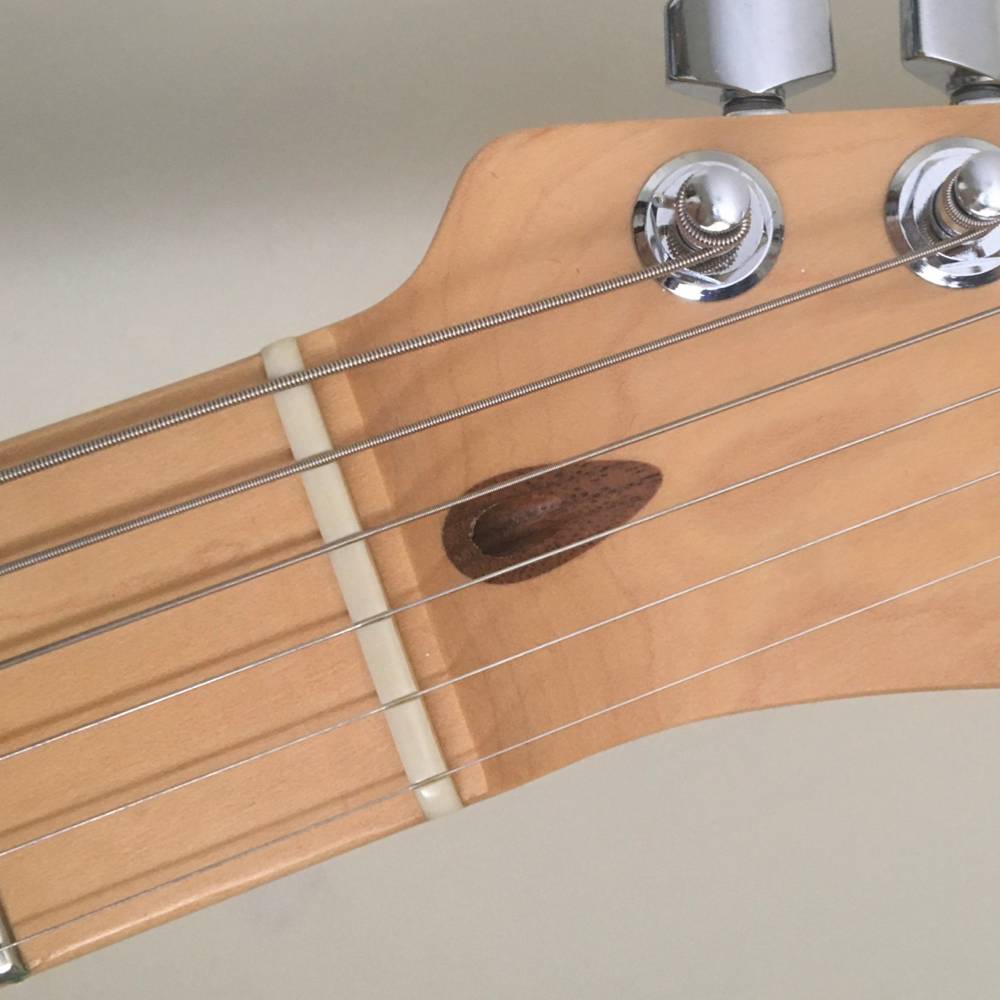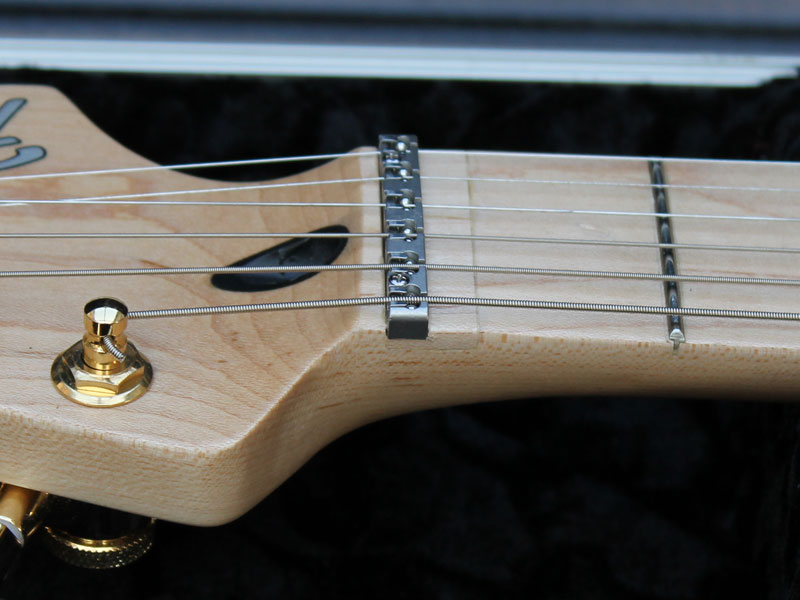There are many different types of guitar nuts and they are all made from a variety of materials. The nut has a noticeable effect on a guitars tone and how it plays. Due to its diminutive size it’s often an overlooked but important part of the guitar.
But it can be hard to keep track of each different guitar nut type and the materials used. Not to mention which type of nut is best suited for different music styles and specific guitars.

So we’re going to take an in-depth look at the different guitar nut types and explain what they are, how they differ and what they’re best suited for.
What is a Guitar Nut?
The guitar nut is the small block of material found at the head of the guitar. It seats the guitar strings and keeps them at the correct spacing. It also affects the height the strings are from the fretboard, the intonation and tone of the guitar.
The nut is usually made of plastic, graphite or bone (although other materials are used) and comes in different shapes and sizes.
It can also impact how the guitar plays and sounds. The material the nut is made from and how dense it is will influence the resonance and sustain the guitar produces.
Are All Guitar Nuts the Same?
No, across electric and acoustic guitars the nuts differ in both size, material and type.
Depending on the guitar and it’s neck width you will get varying width of nuts too. The wider the neck the wider the nut will need to be too, and vice versa for narrower necks.
The material the nut is made from differs too. Higher quality guitars use better quality nut materials like bone whereas the lower end guitars use cheaper materials like plastic.
And then the nut types differ depending on the guitar and what your personal preference is. Different types of guitar nuts are designed for and suit different styles of playing.
Acoustic Guitar Nut vs Electric Guitar Nut
The main differences between acoustic guitar nuts and electric guitar nuts are the sizes. They both use the same materials for nuts but electric guitars tend to have narrower necks and thinner string gauges. This makes the nuts smaller in width and have shallower slots for the strings.
There are some specific types of nuts that are only designed for and used on electric guitars: roller nuts, locking nuts etc. (see below for more details). But the function of the nut is the same across all types of guitars.
Different Types of Guitar Nuts
There are 5 common types of guitar nuts. If you look at virtually any guitar they will have one of these nuts.
Standard Nut
The standard guitar nut is by far and away the most common type of nut. You will find it on most guitars of all prices and brands.
There’s nothing fancy about the standard nut, it just does its job and does it well. Although some nuts do their jobs better than others depending on their quality.
Bone, graphite or TUSQ are usually the best materials for nuts. They are strong, durable but don’t affect the tone too much. Plastic nuts are usually found in the lower end guitars and may be badly cut or soft and so affect the tuning stability of the guitar.
Advantages
- Straightforward and used in most guitars.
- No issues with setup.
- Easy to replace or fix.
- Cheap replacements.
Disadvantages
- Less tuning stability than other nuts.
- Less features or flexibility.

Locking Nut
A locking nut is used in conjunction with the Floyd Rose tremolo system. It is different to most other nuts as instead of the strings sitting in the ruts or grooves of the nut they are held in place or ‘locked’ by clamps.
You can then adjust those clamps in 3 positions using an allen key. They are designed to keep the strings from going out of tune when the whammy bar is used and to prevent the strings sliding over the nut.
Advantages
- It’s very stable and works exactly as you would want it to.
- Allows you to perform guitar ‘tricks’ like divebombs without the strings losing tuning.
Disadvantages
- More difficult to change strings.
- Takes much longer and more effort to change tunings.
- General setup of the guitar is more complicated with a Floyd Rose.

Musiclily Pro 43mm Guitar Locking Nut String Lock for Floyd Rose
Compensated Nut
Compensated nuts, also referred to as a staggered nut, takes each string and adjusts the distance between the first fret and the nut individually. A regular guitar nut lets the strings cross the first fret all at the same distance.
A good way to think of it is like the bridge saddles. The strings move individually backwards or forwards at the nut which helps to improve stability and intonation.
The picture below should help to show exactly how it works
Advantages
- Improves tuning stability.
- Better intonation.
Disadvantages
- Can be expensive.
- Often not really necessary.

Zero Fret Nut
A zero fret nut isn’t really a nut at all. Instead it’s an extra fret in place of the nut. It means the nut only works to space the strings rather than affect the tone or action.
The zero fret makes a guitar sound like it is being fretted even when the open strings are played. They aren’t very common in guitars nowadays and will be listed as a specific feature if so.
Advantages
- Ability to change string gauges without having to cut, file or replace the nut.
- As the strings are constantly touching a fret playing the open strings gives them the tone of fretted notes.
- Strings don’t get caught on the side of the nut.
Disadvantages
- As the zero fret wears down it really affects how you can bend strings. Think of it like a very worn fret.
- Awkward and expensive to replace zero frets.

Zero Glide Slotted ZS-1 Guitar Nut System for Gibson
Roller Nut
A roller nut has small ball bearings within the nut that help the strings move. The ball bearings replace nut grooves or slots.
Roller nuts are mainly used with tremolo systems, so when the whammy bar is used it helps the strings to move back and forth and reduces friction. The lack of nut slots means that the strings shouldn’t get stuck either.
Fender popularized the roller nut and used it in some of their flagship guitars but it is now a lot less commonly used.
Advantages
- When using a tremolo system you don’t have to lubricant the nut.
- After bending with the whammy bar badly cut nuts can affect tuning. Roller nuts eliminate this issue.
- You don’t need a wrench or allen key to adjust or unlock like you do with a Floyd Rose.
Disadvantages
- Affects intonation.
- Tone not as good as with high quality regular nuts.
- No ability to cut or file the nut making them less flexibile.

Image Source
Guitar Nut Materials
Guitar nuts are made from a variety of different materials. Some are better than others and some are more suited to certain types of guitars or music styles.
Plastic
Plastic nuts are one of or the most common nut material. Most lower end and mid level guitars have plastic nuts.
Whilst not all plastic nuts are bad many have issues. Soft plastics will have a big impact on how well the guitar stays in tune. Also the cheaper the guitar there is usually a lack of quality control which leads to badly cut or seated nuts.
Having said that plastic nuts don’t have to be bad. Many are fine and if you get a decent guitar that has been checked properly with a well cut plastic nut it will be fine.

Musiclily Pro Urea Resin Plastic Slotted 44mm Electric Guitar Les Paul Nuts
Bone
Bone nuts are widely considered the best nuts for tone and tuning stability. They are the most traditional and found in some of the best guitars.
Bone is strong but also easy to cut and shape and it’s favored amongst guitarists because of the tone and sustain it provides.
But as it’s a natural material it means it lacks the consistency of something manmade. That means each bone nut will be a little different and in turn the tone or sound will be different.

Fender Vintage Style Stratocaster/Telecaster Electric Guitar Pre-Slotted Bone Nut
Metal
There are many different types of metal guitar nuts: brass, steel, titanium etc. Nowadays though you find very few guitars with metal nuts.
This is because they have such a distinctive sound. They are extremely bright and for most guitarists that brightness is just too much.
On the plus side a metal nut is very strong and durable. It’s far less likely to break it crack than most other types of guitar nuts.

Guyker 43mm Guitar Titanium Alloy Nut – Pre-Slotted Nuts Replacement Compatible with Fender Strat ST Style Electric Guitar
Tusq
Tusq is a better and more dense type of plastic. It was intended as a replacement for bone nuts and does a very good job.
The differences between bone and Tusq are hard to hear or notice and as Tusq is usually cheaper it makes it an excellent alternative.

TUSQ Slotted Nut for Electric Guitar
Graphite
A very popular material fur guitar nuts, graphite has many positives and very few drawbacks. It’s tough and durable so less prone to cracking or breaking. It doesn’t have a major impact on tone and self lubricates so is able to withstand some heavy tremolo use.
It can reduce the sustain of the guitar and make everything sound slightly duller. But this tends to only be a problem with very chap graphite nuts. Generally they are excellent.

Graphtech Guitar Top Nut
Conclusion
There are many different types of guitar nuts and it can be a little confusing if you’re not familiar with them. But the nut of a guitar is very important and shouldn’t be overlooked.
If you want to get your guitar sounding and playing it’s best then a good nut is essential. So hopefully you’ve now got a better understanding of the guitar nut types and the differences between them, and that will help you with making decisions as you go forward with your guitar.